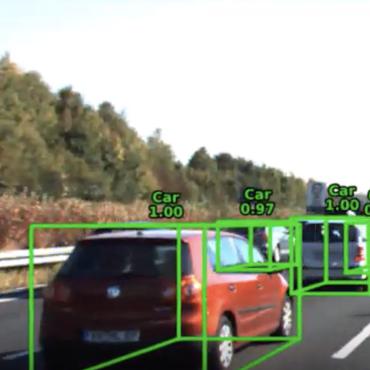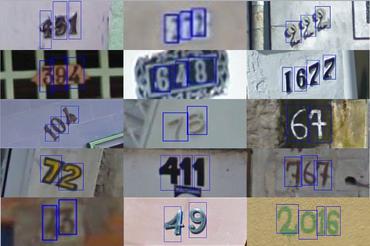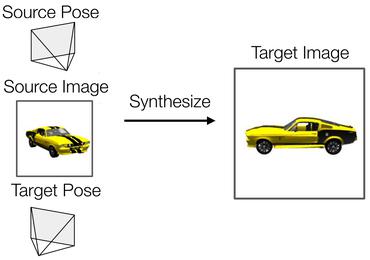Search Results for author: Wei Hua
Found 21 papers, 10 papers with code
Roadside Monocular 3D Detection via 2D Detection Prompting
no code implementations • 1 Apr 2024 • Yechi Ma, Shuoquan Wei, Churun Zhang, Wei Hua, Yanan Li, Shu Kong
Our method builds on a key insight that, compared with 3D detectors, a 2D detector is much easier to train and performs significantly better w. r. t detections on the 2D image plane.
3D-SceneDreamer: Text-Driven 3D-Consistent Scene Generation
no code implementations • 14 Mar 2024 • Frank Zhang, Yibo Zhang, Quan Zheng, Rui Ma, Wei Hua, Hujun Bao, Weiwei Xu, Changqing Zou
Text-driven 3D scene generation techniques have made rapid progress in recent years.
Long-Tailed 3D Detection via 2D Late Fusion
no code implementations • 18 Dec 2023 • Yechi Ma, Neehar Peri, Shuoquan Wei, Wei Hua, Deva Ramanan, Yanan Li, Shu Kong
Autonomous vehicles (AVs) must accurately detect objects from both common and rare classes for safe navigation, motivating the problem of Long-Tailed 3D Object Detection (LT3D).
Beyond Isolation: Multi-Agent Synergy for Improving Knowledge Graph Construction
1 code implementation • 5 Dec 2023 • Hongbin Ye, Honghao Gui, Aijia Zhang, Tong Liu, Wei Hua, Weiqiang Jia
Knowledge graph construction (KGC) is a multifaceted undertaking involving the extraction of entities, relations, and events.
Holistic Inverse Rendering of Complex Facade via Aerial 3D Scanning
no code implementations • 20 Nov 2023 • Zixuan Xie, Rengan Xie, Rong Li, Kai Huang, Pengju Qiao, Jingsen Zhu, Xu Yin, Qi Ye, Wei Hua, Yuchi Huo, Hujun Bao
In this work, we use multi-view aerial images to reconstruct the geometry, lighting, and material of facades using neural signed distance fields (SDFs).
M$^3$CS: Multi-Target Masked Point Modeling with Learnable Codebook and Siamese Decoders
no code implementations • 23 Sep 2023 • Qibo Qiu, Honghui Yang, Wenxiao Wang, Shun Zhang, Haiming Gao, Haochao Ying, Wei Hua, Xiaofei He
Specifically, with masked point cloud as input, M$^3$CS introduces two decoders to predict masked representations and the original points simultaneously.
Cognitive Mirage: A Review of Hallucinations in Large Language Models
1 code implementation • 13 Sep 2023 • Hongbin Ye, Tong Liu, Aijia Zhang, Wei Hua, Weiqiang Jia
Our contribution are threefold: (1) We provide a detailed and complete taxonomy for hallucinations appearing in text generation tasks; (2) We provide theoretical analyses of hallucinations in LLMs and provide existing detection and improvement methods; (3) We propose several research directions that can be developed in the future.
ICDAR 2023 Competition on Structured Text Extraction from Visually-Rich Document Images
no code implementations • 5 Jun 2023 • Wenwen Yu, Chengquan Zhang, Haoyu Cao, Wei Hua, Bohan Li, Huang Chen, MingYu Liu, Mingrui Chen, Jianfeng Kuang, Mengjun Cheng, Yuning Du, Shikun Feng, Xiaoguang Hu, Pengyuan Lyu, Kun Yao, Yuechen Yu, Yuliang Liu, Wanxiang Che, Errui Ding, Cheng-Lin Liu, Jiebo Luo, Shuicheng Yan, Min Zhang, Dimosthenis Karatzas, Xing Sun, Jingdong Wang, Xiang Bai
It is hoped that this competition will attract many researchers in the field of CV and NLP, and bring some new thoughts to the field of Document AI.
SelFLoc: Selective Feature Fusion for Large-scale Point Cloud-based Place Recognition
no code implementations • 1 Jun 2023 • Qibo Qiu, Haiming Gao, Wenxiao Wang, Zhiyi Su, Tian Xie, Wei Hua, Xiaofei He
To enhance message passing along particular axes, Stacked Asymmetric Convolution Block (SACB) is designed, which is one of the main contributions in this paper.
Visual Information Extraction in the Wild: Practical Dataset and End-to-end Solution
1 code implementation • 12 May 2023 • Jianfeng Kuang, Wei Hua, Dingkang Liang, Mingkun Yang, Deqiang Jiang, Bo Ren, Xiang Bai
We evaluate the existing end-to-end methods for VIE on the proposed dataset and observe that the performance of these methods has a distinguishable drop from SROIE (a widely used English dataset) to our proposed dataset due to the larger variance of layout and entities.
SOOD: Towards Semi-Supervised Oriented Object Detection
1 code implementation • CVPR 2023 • Wei Hua, Dingkang Liang, Jingyu Li, Xiaolong Liu, Zhikang Zou, Xiaoqing Ye, Xiang Bai
Semi-Supervised Object Detection (SSOD), aiming to explore unlabeled data for boosting object detectors, has become an active task in recent years.
I$^2$-SDF: Intrinsic Indoor Scene Reconstruction and Editing via Raytracing in Neural SDFs
no code implementations • 14 Mar 2023 • Jingsen Zhu, Yuchi Huo, Qi Ye, Fujun Luan, Jifan Li, Dianbing Xi, Lisha Wang, Rui Tang, Wei Hua, Hujun Bao, Rui Wang
In this work, we present I$^2$-SDF, a new method for intrinsic indoor scene reconstruction and editing using differentiable Monte Carlo raytracing on neural signed distance fields (SDFs).
Turning a CLIP Model into a Scene Text Detector
1 code implementation • CVPR 2023 • Wenwen Yu, Yuliang Liu, Wei Hua, Deqiang Jiang, Bo Ren, Xiang Bai
Recently, pretraining approaches based on vision language models have made effective progresses in the field of text detection.
I2-SDF: Intrinsic Indoor Scene Reconstruction and Editing via Raytracing in Neural SDFs
no code implementations • CVPR 2023 • Jingsen Zhu, Yuchi Huo, Qi Ye, Fujun Luan, Jifan Li, Dianbing Xi, Lisha Wang, Rui Tang, Wei Hua, Hujun Bao, Rui Wang
Further, we propose to decompose the neural radiance field into spatially-varying material of the scene as a neural field through surface-based, differentiable Monte Carlo raytracing and emitter semantic segmentations, which enables physically based and photorealistic scene relighting and editing applications.
SASFormer: Transformers for Sparsely Annotated Semantic Segmentation
1 code implementation • 5 Dec 2022 • Hui Su, Yue Ye, Wei Hua, Lechao Cheng, Mingli Song
In this work, we propose a simple yet effective sparse annotated semantic segmentation framework based on segformer, dubbed SASFormer, that achieves remarkable performance.
PriorLane: A Prior Knowledge Enhanced Lane Detection Approach Based on Transformer
1 code implementation • 15 Sep 2022 • Qibo Qiu, Haiming Gao, Wei Hua, Gang Huang, Xiaofei He
Lane detection is one of the fundamental modules in self-driving.
An Interactive Image-based Modeling System
no code implementations • 28 Mar 2022 • Zhi He, Rui Wang, Wei Hua, Yuchi Huo
This paper propose a interactive 3D modeling method and corresponding system based on single or multiple uncalibrated images.
AttentionNAS: Spatiotemporal Attention Cell Search for Video Classification
no code implementations • ECCV 2020 • Xiaofang Wang, Xuehan Xiong, Maxim Neumann, AJ Piergiovanni, Michael S. Ryoo, Anelia Angelova, Kris M. Kitani, Wei Hua
The discovered attention cells can be seamlessly inserted into existing backbone networks, e. g., I3D or S3D, and improve video classification accuracy by more than 2% on both Kinetics-600 and MiT datasets.
MediaPipe: A Framework for Building Perception Pipelines
2 code implementations • 14 Jun 2019 • Camillo Lugaresi, Jiuqiang Tang, Hadon Nash, Chris McClanahan, Esha Uboweja, Michael Hays, Fan Zhang, Chuo-Ling Chang, Ming Guang Yong, Juhyun Lee, Wan-Teh Chang, Wei Hua, Manfred Georg, Matthias Grundmann
A developer can use MediaPipe to build prototypes by combining existing perception components, to advance them to polished cross-platform applications and measure system performance and resource consumption on target platforms.
Distributed, Parallel, and Cluster Computing
Auto-DeepLab: Hierarchical Neural Architecture Search for Semantic Image Segmentation
12 code implementations • CVPR 2019 • Chenxi Liu, Liang-Chieh Chen, Florian Schroff, Hartwig Adam, Wei Hua, Alan Yuille, Li Fei-Fei
Therefore, we propose to search the network level structure in addition to the cell level structure, which forms a hierarchical architecture search space.
 Ranked #7 on
Semantic Segmentation
on PASCAL VOC 2012 val
Ranked #7 on
Semantic Segmentation
on PASCAL VOC 2012 val
Progressive Neural Architecture Search
18 code implementations • ECCV 2018 • Chenxi Liu, Barret Zoph, Maxim Neumann, Jonathon Shlens, Wei Hua, Li-Jia Li, Li Fei-Fei, Alan Yuille, Jonathan Huang, Kevin Murphy
We propose a new method for learning the structure of convolutional neural networks (CNNs) that is more efficient than recent state-of-the-art methods based on reinforcement learning and evolutionary algorithms.
 Ranked #15 on
Neural Architecture Search
on NAS-Bench-201, ImageNet-16-120
(Accuracy (Val) metric)
Ranked #15 on
Neural Architecture Search
on NAS-Bench-201, ImageNet-16-120
(Accuracy (Val) metric)












